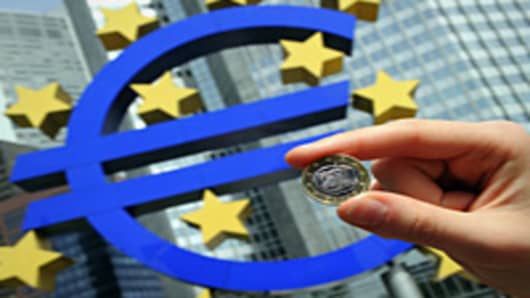Fears that Europe will drag the world into recession—and no new signals of relief from the Fed —combined to pressure the euro and trigger a selling wave across risk assets.
The moves were exacerbated by the year-end which has some investors looking to square positions and creates less liquid conditions in some markets.
“While everyone was sure a year-end rally would occur, it seems like everyone’s throwing in the towel,” said Daniel Greenhaus, chief global strategist at BTIG. "We're running out of time for a Santa rally. People are just not happy with the investing environment right now."
The euro made an important break below 1.30 Wednesday. Traders have been watching the single currency decline since European leaders ended last week's summit with no big framework for a solution to the debt crisis and no promise of one.
But perhaps the worse development for markets was the European Central Banks’s stated position that it would not be a major buyer of sovereign debt, which traders saw as a way to keep rates from rising further for struggling economies.
“Really what you have is the reversal of the spike, which was predicated on larger ECB purchases. The Federal Reserve is no closer to QE3, much to everyone’s chagrin, so the idea of more central bank intervention is not there to support gold prices,” said Greenhaus.
Oil and gold skidded both down about 5 percent. Gold was as low as $1,565 and below its 200-day moving average for the first time in three years. It finished the session at $1584.34, down $75.60 per ounce.
NYMEX crude lost $5.19 per barrel, ending the New York session at $94.95.
The Dow ended down 131 points at 11,823, and the S&P 500 fell 13 to 1211.
Risk assets, like commodities and stocks, have been tightly correlated to the euro. The correlation of stocks to the euro is more than 80 percent on a 60-day basis. According to Factor Advisors, oil and the euro had a realized three-month correlation of nearly 60 percent.
One of the big fears is that European sovereigns will be downgraded by rating agencies, which are reviewing them after the EU summit. “You’ve got a lot of guys running around with wild rumors,” said one stock trader.
A recurring rumor that France would be downgraded resurfaced and was knocked down by a French official.
“We should have been seeing good physical support for gold on the down side and that hasn’t been materializing,” said Suki Cooper, vice president and precious metals analyst at Barclays.
As markets fell in tandem, they also traded with their own specific concerns. Oil, for instance, slipped in part on a commitment from OPEC to produce about the same 30 million barrels per day in 2012 that it produces now.
There were also concerns in all markets that China’s economy will suffer a hard landing, slamming into a world economy already bracing for a European recession.
“It’s all about the euro. The inverse dollar play is back in action here,” said oil analyst John Kilduff of Again Capital.
“It’s really been a need for liquidity, a need for cash that’s weighed on prices,” she said.
Fed watchers did not expect any new word on QE3, or a third quantitative easingprogram, and those that expect more easing were not looking for the Fed to discuss it until next year. Yet, clearly some market participants were disappointed that the Fed did not move its discussion forward to its meeting Tuesday, after the disappointing response by European officials to their debt crisis.
“I don’t think anyone expected it to be implemented or announced yesterday. The consensus of the economists and Fed watching community was they’d have a discussion about their communications policy and the economy is doing a little better so they really wanted to have a quiet meeting. It was kind of one of those “if it it ain’t broke, don’t fix it” for the Fed’s approach,” said Robert Sinche, chief G10 currency strategist at RBS.
But, he notes, some investors clearly saw things differently after the the Fed’s statement gave no new promise of easing. “Everyone looked at the other stuff and said this is not good …the Fed was our last hope for a wink and a nod on liquidity and it didn’t come,” he said.
Follow Patti Domm on Twitter: @pattidomm



